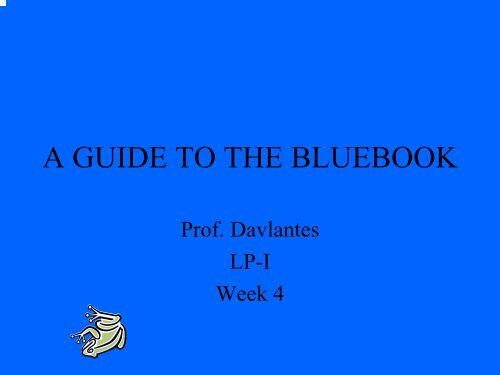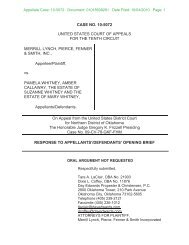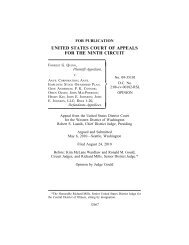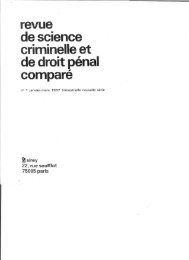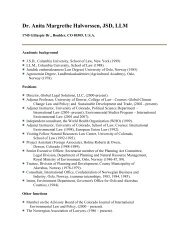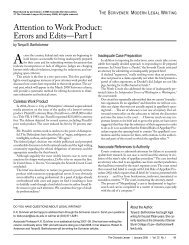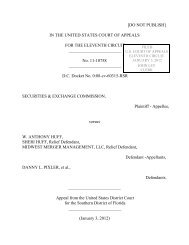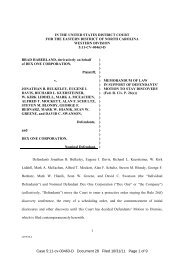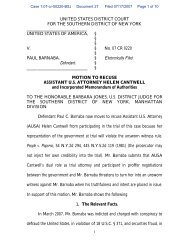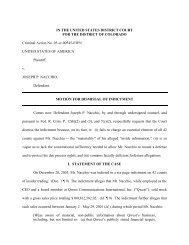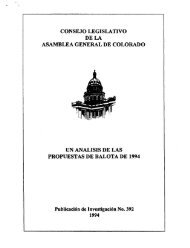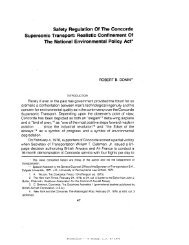THE BLUEBOOK MADE EASY
THE BLUEBOOK MADE EASY
THE BLUEBOOK MADE EASY
You also want an ePaper? Increase the reach of your titles
YUMPU automatically turns print PDFs into web optimized ePapers that Google loves.
A GUIDE TO <strong>THE</strong> <strong>BLUEBOOK</strong><br />
Prof. Davlantes<br />
LP-I<br />
Week 4
Navigating the Bluebook<br />
• Quick References (at front and back)<br />
• Practitioner’s Notes (blue pages in front)<br />
• Rules (white pages in middle)<br />
• Tables and Abbreviations (blue pages in<br />
back)<br />
• Index (white pages in back)
You Must Cite to Supporting<br />
• You make an<br />
assertion about the<br />
law<br />
• You quote directly<br />
from a legal source<br />
• You paraphrase from<br />
a legal source<br />
Authority When:
Citation of American Case Law<br />
• Federal cases: The<br />
Supreme Court of the<br />
United States is the<br />
only federal court to<br />
officially report its<br />
cases. This reporter is<br />
the United States<br />
Reports (U.S.)<br />
• The Bluebook requires<br />
citation only to the<br />
official report<br />
• Supreme Court Opinions are<br />
also published in three<br />
unofficial reporters:<br />
1. Supreme Court Reporter<br />
(S. Ct.)<br />
2. Lawyer’s Edition (L. Ed.)<br />
Lawyer’s Edition, Second<br />
Series (L. Ed. 2d)<br />
3. United States Law Week<br />
(U.S.L.W.)
Citations of Federal Cases, cont.<br />
• Federal courts of appeal<br />
decisions are published by<br />
West in the unofficial<br />
reporter, Federal Reporter<br />
2d and 3d (F.2d and F.3d).<br />
• District court decisions<br />
are published by West in<br />
the unofficial reporter, the<br />
Federal Supplement (F.<br />
Supp.)
State cases & West Regional<br />
Reporters<br />
• 28 states publish their cases officially.<br />
• The other 22 states rely on the unofficial<br />
West reporters to publish their cases in<br />
seven regional reporters:<br />
– North Eastern (N.E. and N.E.2d)<br />
– North Western (N.W. and N.W.2d)<br />
– Pacific (P. and P.2d)<br />
– South Eastern (S.E. and S.E.2d)<br />
– South Western (S.W. and S.W.2d)<br />
– Southern (S. and S.2d).
New York and California are Odd<br />
• The intermediate court<br />
decisions of these<br />
states are also<br />
published by West in<br />
the New York<br />
Supplement (N.Y.S.<br />
and N.Y.S.2d) and in<br />
the California<br />
Reporter (Cal. Rptr.),<br />
respectively.
How to Cite Cases<br />
Jackson v. Green, 204 So. 2d 94 (Fla. 1974)<br />
case name + reporter (volume, reporter<br />
abbrev., page #) + court and date
Underlining or Italicizing Case Names<br />
• In briefs, memos, and other legal<br />
writings, all case names and<br />
procedural phrases should be<br />
italicized or underscored. In this<br />
class, always underline. The “v.”<br />
should also be underscored.<br />
Iinclude blank spaces between the<br />
words and the case name.<br />
• Incorrect: Jones v. Smith<br />
In re Jones<br />
• Correct: Jones v. Smith<br />
In re Jones
Cite only the first listed party on<br />
each side<br />
• John P. Jones, Franklin W. Bailey,<br />
Plaintiffs v. Glenn M. Adams, and<br />
Stephen Lamieux, Defendants<br />
– Jones v. Adams<br />
• If two or more cases are consolidated, cite<br />
only the first-listed parties of each side of<br />
the first-listed action.
Cite individuals by last name only<br />
• Do not include “et. al.” to show multiple parties;<br />
no first names or initials; no “d/b/a” or “a/k/a”;<br />
do not include legal status such as<br />
Administrator, Executor, Plaintiff, Defendant,<br />
Appellant, Appellee, Guardian, etc.<br />
Incorrect Correct<br />
Smith et. al. v. Jones Smith v. Jones<br />
John E. Smith v. Jill Jones Smith v. Jones<br />
Smith d/b/a Flower Power Smith v. Jones<br />
v. Jones
Business Names<br />
• If a business uses more than one business<br />
term in its name, drop all but the first.<br />
Incorrect:<br />
Pacific Palisades Co., Inc. v. A.V. Jones<br />
Correct:<br />
Pacific Palisades Co. v. Jones
Citing a Decision Involving a State<br />
• To cite a state, use either the word “State,”<br />
“Commonwealth,” or “People,” depending on<br />
which appears on the title page, if citing to a case<br />
decided by that state’s state court. Use the name of<br />
the state if citing to a case not decided by that<br />
state’s state court. Never use both.<br />
• Ex: The State of Arizona v. Jonathan P. Jones<br />
• If case cited by Arizona court, then: State v. Jones<br />
• If cited by another court: Arizona v. Jones
Citing a City in a Case Name<br />
• To cite a city or county, cite it<br />
the way it appears on the title<br />
page. Omit name of state<br />
though.<br />
• Incorrect: City of Memphis,<br />
Tennessee v. Jonathan P. Jones<br />
• Correct: City of Memphis v.<br />
Jones
When United States is a Party<br />
• United States of<br />
America is always<br />
cited as “United<br />
States”<br />
– not U.S.A.<br />
– not U.S.<br />
– not United States of<br />
America<br />
– not the big Red, White<br />
and Blue
Titles of government officials<br />
• Cite only to the person’s last name and omit<br />
the title completely.<br />
Incorrect: Harris, Secretary of the Department<br />
of Health and Human Services v. Citicorp<br />
Correct: Harris v. Citicorp<br />
• Exception: Commissioner of Internal Revenue.<br />
Incorrect: Commissioner of Internal Revenue v.<br />
Fred C. Smith<br />
Correct: Commissioner v. Smith
In rem actions<br />
• Actions involving objects such as land or goods<br />
are known as “in rem” actions.<br />
Ex.: condemnation proceedings or proceedings<br />
against contraband property. Omit all but firstlisted<br />
item or group of items.<br />
• Incorrect: In re Fifty Kilograms of Cocaine,<br />
Twelve Cases of Potato Chips, and One Milky<br />
Way Bar<br />
• Correct: In re Fifty Kilograms of Cocaine
When Real Property is a Party<br />
• When real property is a party, use its street<br />
address and omit all other words.<br />
• Incorrect: United States v. Real Property<br />
Situated at 13 Fernbank Lane, County of<br />
Duval, State of Florida<br />
• Correct: United States v. 13 Fernbank Lane
Use of “the” in party names<br />
• Omit “The” as the first word<br />
of a party’s name unless the<br />
party’s name is “The King,”<br />
“The Queen,” or the name of<br />
an object in an in-rem action.<br />
• Incorrect: The Heekin Co. v.<br />
Fred Franklin<br />
• Correct: Heekin Co. v.<br />
Franklin
Prepositional Phrases of Location<br />
• Omit prepositional phrases of<br />
location unless the resulting<br />
citation leaves only one word in<br />
the case name or an<br />
insufficiently identified case<br />
name.<br />
• Incorrect: Brown v. Board of<br />
Education of Albemarle County<br />
• Correct: Brown v. Board of<br />
Education
Abbreviations: The Bluebook has two different<br />
systems for abbreviating: Heavy and Light.<br />
• The Light Abbreviation System is used for<br />
case names appearing in the grammatical part of textual<br />
sentences and in complete sentences in footnotes. (Rule<br />
10.2.1)<br />
• Only eight words are abbreviated:<br />
Company = Co. Corporation = Corp.<br />
Incorporated = Inc. Limited = Ltd.<br />
Number = No. And =&<br />
Association = Ass’n Brothers = Bros.<br />
C Any widely known acronym may also be used, e.g.,<br />
National Labor Relations Board = NLRB.
The Heavy Abbreviation System<br />
• All words in case names, other than the first<br />
word of either party’s name, is abbreviated if it<br />
is listed in Table 6 on pages 302-03 of the<br />
Bluebook (Rule 10.2.2).<br />
• Used for case names appearing in citations, i.e.,<br />
one that is not part of a grammatical sentence.<br />
• Ex: Although it is generally recognized that landlords have a<br />
duty to protect tenants against foreseeable third party criminal<br />
attacks, see, e.g., Isaacs v Huntington Mem’l Hosp., 695 P.2d<br />
653 (Cal. 1985), the court in Ann M. v. Pacific Plaza Shopping<br />
Center, 863 P.2d 207 (Cal. 1993), restricted this liability by<br />
requiring the application of a balancing test.
Forming abbreviations<br />
• The Bluebook uses two methods of abbreviating<br />
words.<br />
– The contraction technique takes the first three<br />
letters of a word plus the last letter. An<br />
apostrophe is used before the last letter but no<br />
period.<br />
Ex: “department” is abbreviated “dep’t”, not<br />
“dept.”<br />
– The scrunched technique is used when various<br />
letters of the word are chosen as the<br />
abbreviation. Use a period at the end.<br />
Ex: “building” is abbreviated “bldg.”
Procedural Phrases<br />
• “Ex rel.” is the abbreviation for “on the relation<br />
of,” “for the use of,” “on behalf of,” and similar<br />
expressions.<br />
• This type of proceeding occurs when one party is<br />
suing on behalf of another. (Rule 10.2.1(b))<br />
• Ex: James P. Smith, Attorney General for the State<br />
of Mississippi, for the use of Jane P. Jones v. Fred<br />
Jones is cited as Smith ex rel. Jones v. Jones.
Procedural Phases<br />
• “In re” is the abbreviation for “in the matter<br />
of,” “petition of,” “application of,” and the<br />
like.<br />
• These cases might involve the probate of a<br />
will or a bankruptcy proceeding.<br />
• Ex: In the Matter of the Will Jane L. Lester<br />
is cited In re Will of Lester.
Parallel Citation Rule (PC Rule)<br />
• When citing a given state’s cases to that<br />
state’s courts, always provide parallel<br />
citations to the official and unofficial<br />
reports. Cite the official report first and<br />
then the unofficial West reporter. In all<br />
other documents, however, do not provide<br />
parallel citations. Cite only to the official<br />
West reporter.
Examples of PC Rule<br />
• Incorrect (PC Rule):<br />
123 S.E.2d 115, 217 Ga. 234 (1971)<br />
• Correct (PC Rule):<br />
217 Ga. 234, 123 S.E.2d 115 (1971)<br />
• Incorrect (No PC Rule):<br />
123 S.E.2d 115, 217 Ga. 234 (1971)<br />
217 Ga. 234, 123 S.E.2d 115 (1971)<br />
• Correct (No PC Rule):<br />
123 S.E.2d 115 (Ga. 1971)
How to Cite the Parentheses<br />
Each case citation must include the precise<br />
identity of the court deciding the case. Most<br />
official court reports publish the opinion of just<br />
one court. Thus, when following the PC Rule, by<br />
naming the court report, the court is also<br />
identified. In the parentheses, identify the court<br />
deciding the case by using Table 1 of the<br />
Bluebook.<br />
• Ex: Jackson v. Green, 143 Va. 423, 218 S.E.2d<br />
453 (1971) = PC Rule<br />
Jackson v. Green, 218 S.E.2d 453 (Va. 1971)<br />
= No PC Rule
How to Cite Case History<br />
• Legal writers must reveal all subsequent case<br />
history occurring in a higher court.<br />
Ex: Jones v. Smith, 235 F. Supp. 102 (S.D.N.Y.<br />
1965), aff’d, 312 F.2d 901 (2d Cir. 1966).<br />
• Prior history is cited only if the attorney wishes to<br />
alert the reader to what happened at the lower<br />
court level.<br />
Ex: Jones v. Smith, 312 F.2d 901 (2d Cir. 1966),<br />
aff’g 235 F. Supp. 102 (S.D.N.Y. 1965)
Short Citation Forms<br />
• The first time you cite to<br />
a case, use its full<br />
citation. After that, use<br />
one of these forms of<br />
short cites:<br />
– United States v. Calandra,<br />
414 U.S. at 343<br />
– Calandra, 414 U.S. at 343<br />
– 414 U.S. at 343<br />
–Id.at 343<br />
• Use Id.only if there<br />
are no intervening<br />
cases<br />
• Ex: The court affirmed<br />
the judgment. Smith<br />
v. Wells, 42 So. 2d<br />
832 (Fla. 1999). The<br />
plaintiffs were<br />
awarded $10,000. Id.<br />
at 833.
Citing to Secondary Authority<br />
• Legal encyclopedias (Rule 15.7)<br />
Give volume-name of source-topic-sectionat<br />
page (date)<br />
Ex: 42 C.J.S. Trials § 43, at 692 (1965)
Citing to Secondary Authority<br />
• Annotated Reports (Rule 16.6.5)<br />
Give author’s full name, Annotation, Title<br />
of Annotation, volume A.L.R. (1st, 2d, 3d,<br />
4th, 5th, or Fed.) Section, at page (date)<br />
Ex: Susan Smith, Annotation, Search and<br />
Seizure Rights of the Accused, 94 A.L.R.3d<br />
§ 14, at 29 (1968)
Citing to Secondary Authority<br />
• Treatises (Rule 15)<br />
Give correct volume (if more than one), full name<br />
of the author in the same way the author cites him<br />
or herself, name of treatise (underlined), section,<br />
page, correct edition of the treatise in a<br />
parenthetical. If treatise has two authors, include<br />
the full name of both. If treatise has more than two<br />
authors, cite only first listed author and include “et<br />
al.” after the first author’s full name.<br />
Ex: 1 Ken C. Davis, Administrative Law Treatise<br />
§ 6.18, at 419 (1958)
Citing to Secondary Authority<br />
• Periodical Articles (Rule 16)<br />
Give author’s Full name, Title of the Article,<br />
Volume number of the law review, properly<br />
abbreviated name of the law review, page number<br />
where the article begins, and a parenthetical date<br />
at the end.<br />
Ex: William G. Pederson, Jr., The Decline of<br />
Separation of Functions in Regulatory Agencies,<br />
64 Va. L. Rev. 991 (1978).
Citing to Secondary Authority<br />
• Periodical Articles (continued)<br />
If the article is a Note, Comment, Case Comment,<br />
or Special Project written by a law student, the<br />
citation should include the type of article to show<br />
that it is a student-produced work.<br />
Ex: Miles Elmore, Note, Surviving First Year in<br />
Law School, 18 Stan. L. Rev. 680 (1966).
Signal Words<br />
• Utilize to indicate when legal authority supports a<br />
proposition, contradicts a proposition, is analogous to<br />
a proposition, or provides general background<br />
material. All signal words are italicized or underlined<br />
when used in citation sentences or clauses.<br />
• If used as the verb of a sentence, signal words are not<br />
underlined or italicized.<br />
Ex: See is used to indicate that the authority cited<br />
clearly supports the proposition of law but does not<br />
directly state it.<br />
But see is used to indicate that the authority clearly<br />
supports a proposition contrary to the main<br />
proposition.
Signal Words, continued<br />
• No signal means the<br />
cited authority:<br />
1. Directly states the<br />
proposition<br />
2. Identifies the source of<br />
a quotation<br />
3. Identifies an authority<br />
referred to in text.
Pinpoint Citing<br />
• The citation of a case or law review article should<br />
include the page on which the document begins.<br />
The writer may also include a specific reference to<br />
the precise page where a quotation or legal<br />
proposition appears (pinpoint cite). In this case, the<br />
specific page follows the beginning page. Each<br />
page number is separated by a comma.<br />
Ex: Jones v. Smith, 234 F.2d 12, 14 (4th<br />
Cir. 1971).<br />
• When multiple, non-consecutive pages are cited,<br />
these pages should be separated by commas.<br />
Ex: Jones v. Smith, 234 F.2d 12, 14, 17 (4th<br />
Cir. 1971).
Citing Consecutive Page Numbers<br />
• When multiple, consecutive<br />
pages are cited, the first and<br />
last numbers should be<br />
separated by a hyphen, and<br />
all but the last two digits<br />
from the last page number<br />
should be dropped.<br />
Ex: Jones v. Smith, 335 F.2d<br />
756, 758-60 (2d Cir. 1973).
Citing Statutes (Rule 12)<br />
• Federal Statutes<br />
To cite an entire statute codified in the United States Code,<br />
give the official name of the act + the title number+Code<br />
abbrev.+§ or §§+parenthetical date (and supplement, if<br />
appropriate)<br />
Ex: Americans with Disabilities Act, 42 U.S.C.<br />
§ 12101 (1194)<br />
To cite an individual provision of the United States Code,<br />
give title number+Code abbrev.+§ or §§+parenthetical date<br />
(and supplement, if appropriate)=Publisher if citing to<br />
U.S.C.A. or U.S.C.S.<br />
Ex: 42 U.S.C. § 1983 (1984)<br />
47 U.S.C. § 303(a)-(d) (1994 & Supp.II 1996)<br />
13 U.S.C.S. § 3724 (Law. Co-op. Supp. 1990)
Bluebook Modifications<br />
• Always check local court rules to<br />
see if the Bluebook rules for<br />
citations have been modified for<br />
your state.<br />
• For example, in Florida, District<br />
Court of Appeal decisions are<br />
cited differently than listed in<br />
Table 1.<br />
Ex: Food Lion, Inc. v. Clifford, 629<br />
So. 2d 201 (Fla. 5th DCA 1993)


